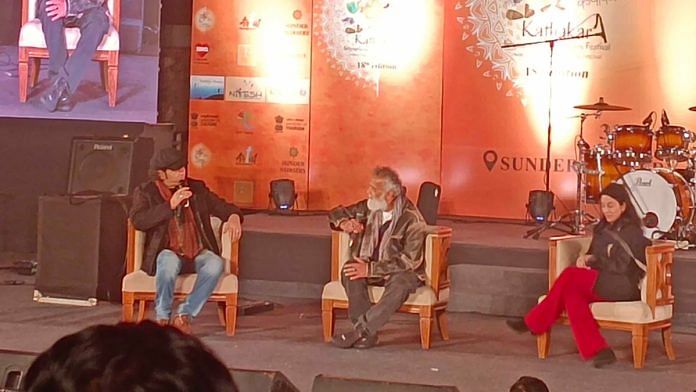New Delhi: On a chilly February night, the amphitheatre at Delhi’s Sunder Nursery became the stage for a horror story. An old woman, desperate to silence her dog’s incessant barking, kills it. She was afraid that the noise would attract the jinn lurking in the dark, said Usifu Jalloh from Sierra Leone.
He was part of the 18th edition of the Kathakar International Storytellers Festival, curated by the Gahilote sisters—Rachna, Prarthana, and Shaguna. The goal is to reacquaint Delhi with the tradition of storytelling beyond India’s borders. For three days, artists from the UK, Estonia, Poland, Israel, and India offered a window to their stories and cultures. The storytelling festival, held from 31 January to 2 February, included musical performances, and conversations with singers, scriptwriters, and directors, like Imtiaz Ali, Anurag Basu, and Lucky Ali.
As he spun his tale, Jalloh transformed into an old woman—complete with the stoop and quavering voice. Moments after the dog falls silent, an unnatural sound fills the air. The dead dog’s body begins to bark, echoing in the quiet of the night. Jalloh howled, continuing with the story.
The woman then sets the carcass on fire, but an ominous presence closes in on her—a growing gathering of jinns, drawn by the barking. The audience gasped as Jalloh took on the persona of the dreaded jinn.
“In a time where we watch seconds-long reels and quickly skip through things, it’s crucial to understand the importance of storytelling and the craft behind it,” said director and screenwriter Anurag Basu, during the panel discussion that followed the performance.
Soon, Jalloh once more transitioned from actor to activist. It was a tale with a moral. The dog, killed by the lady due to its incessant barking, was actually trying to protect her by warding off the jinns.
“Nature and animals always sense things before humans do, and there is an urgent need to protect the environment and its creations,” Jalloh said.
A dying art
The “OG storytellers” are our grandparents, but nobody has the time to listen. With this declaration, Basu expressed concern over how storytelling is fading from our lives. He was in conversation with singer Mohit Chauhan and author Prarthana Gahilote.
Storytellers from various parts of the country and the world showcased their tales in unique ways, using different musical instruments and narrative techniques. Indian artists, including singers and directors, also shared personal stories behind their songs and movies, offering a deeper glimpse into the experiences that shaped their work.
Singer Lucky Ali revealed how his iconic song O Sanam is about a girl, Nazma, he had once fallen for. “Back then, I was just an artist, and I went to her father to ask for his permission to marry his daughter. He was shocked. She (Nazma) told me that she was getting married to someone else. So, ‘O Sanam‘ came from that,” said Ali.
Between the storytelling and musical performances by Taba Chake, Bhupinder Babbal, and Niazi Brothers, among others, Basu took the audience on an emotional rollercoaster through his deeply personal journey of battling cancer.
He spoke candidly about the challenges he faced during his treatment and how it shaped his outlook on life. “When a patient is undergoing treatment or is on a ventilator, they lose track of time—day and night become irrelevant. However, what’s most difficult is what the family members go through,” said Basu.
Also read: There is more to queer life than young couple falling in love, facing challenges, then uniting
A mirror
The listener is as important as the storyteller. Polina Tserkassova from Estonia called it a two-way process. The listener’s engagement, interpretation, and emotional connection are just as vital as the storyteller’s narrative, she said.
Stories act as a mirror to society, reflecting a picture of a person based on their personality, Tserkassova added, before launching into her performance.
She narrated the story of a rich farmer who bought the first mirror in his village. When the villagers looked into the mirror, they assumed that the reflection was the farmer’s girlfriend and began judging him. It wasn’t until the farmer explained that the mirror was showing their own reflections that the confusion was cleared up.
The mirror here was a symbol of truth, reflecting the biases and desires of the people who looked into it.
“Whenever we are listening to stories, whenever we are telling stories, we are being together. There is a special magic in stories which creates a community,” said Tserkassova. This connection between the storyteller and the audience is what gives stories their power and impact.
(Edited by Aamaan Alam Khan)






